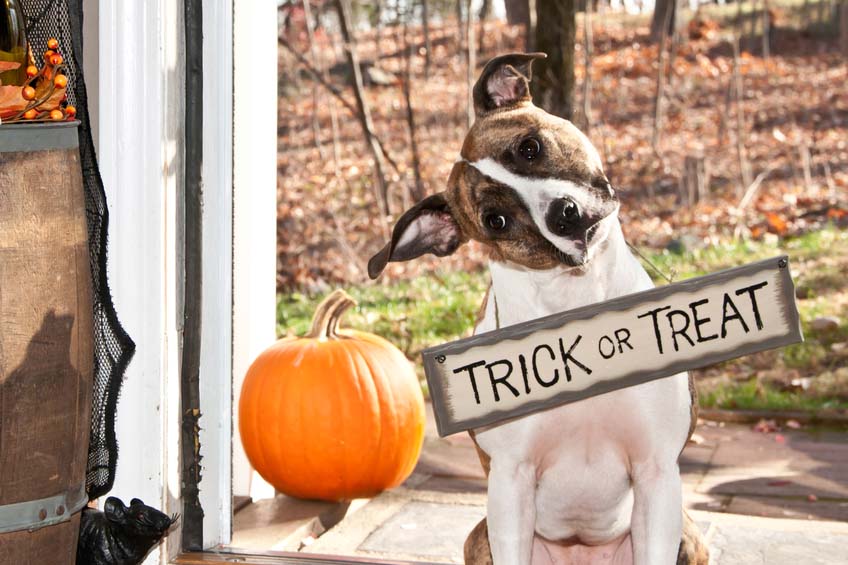Halloween & Fall Hazards For Your Dog
While Halloween brings out all the costumes and tricksters, it also creates certain hazards for our pets.
This is the season of witches, ghouls, and goblins. While Halloween brings out all the costumes and tricksters, it also creates certain hazards for our pets. This blog will explore some of these Halloween hazards and describe what can be done to keep your pet’s household safe and festive.
Chocolate Toxicity: A Serious Concern for Pets
The obvious Halloween hazard that nearly everyone has on his or her radar is chocolate. While the mere mention of the word makes me salivate, it will make your dog and cat salivate for all the wrong reasons.
Chocolate contains two toxins that make it dangerous for our pets. Specifically, they stimulate the nervous system. At low doses it shows up as vomiting, but as the dose increases, clinical signs advance to tremors and later seizures. If left untreated it can lead to high fevers and brain damage, with the most severe cases ending in death.
Cats are the most sensitive to these effects but rarely eat enough to cause signs since it isn’t very appetizing or appealing to them (silly cats prefer things like liver!) Dogs have a moderate sensitivity to the toxins and will readily consume massive amounts of chocolate if given the opportunity. Humans, by comparison, have a low sensitivity to the toxins in chocolate.
The key therefore is prevention. It is quite important to limit your pets’ access to the Halloween stash. We’ll get to more about prevention in a moment. But it’s also important at this point to mention that not all chocolate is equal in terms of its toxicity. The rule of thumb is that the darker the chocolate, the more toxic it is, with dark semisweet baking chocolate containing the highest concentrations.
Artificial Sweeteners: Xylitol Poisoning in Dogs
We humans love our sweets. But we also recognize that they are not particularly good for us. So we use all sorts of artificial sweeteners that taste similar to sugar but without the calories. Unfortunately these can also be dangerously toxic to dogs.
The biggest culprit is xylitol. Xylitol is an artificial sweetener that has become one of the most popular in particular in chewing gum. For humans it not only is a low calorie sweetener but is also known to fight tooth decay and plaque. Because of these qualities, it has found its way into toothpastes, mouthwash, and sweets.
But for dogs this is a deadly toxic substance. In dogs the insulin secreting cells do not recognize xylitol as an artificial sweetener. Rather, the cells sense it as sugar and release insulin in response. But since it is artificial it does not cause an increase in blood glucose.
With insulin secretion it drives circulating glucose into cells particularly in the liver leaving circulating glucose levels dangerously low for critical organs like the brain and heart. The end result can be severe hypoglycemia leading to seizures and death. Be certain to keep any Halloween treats like chewing gum and hard candies that contain xylitol away from dogs.
Rattlesnake and Spider Envenomations: A Real Danger
Trick or Treating is not the only danger to pets this time of year. October is the month when rattlesnake and spider envenomations peak. It’s when the weather finally starts to cool that we start hiking and heading into habitats where snakes are preparing for the winter. This makes them more active, and more likely to be seen along hiking trails.
Dogs may run toward a rattling snake as opposed to away from it, particularly out of curiosity. It is therefore important to avoid areas where rattlesnakes are common. There are rattlesnake avoidance training programs that some dog owners find useful to prevent bites.
With spiders, they are busy hunting so that they can lay eggs, which will hatch in the following spring. The spiders themselves will likely die over the winter, but it is their eggs that will hatch and produce the next generation after winter ends. Most spiders are not harmful to pets and people, but we do have black widow spiders throughout southern California.
While black widows are not aggressive and tend to be reclusive, you should avoid contact and prevent your pets from coming into contact. When black widows are laying eggs, they can be protective and a bit more aggressive this time of year. Black widow spider bites can produce intense pain. If you think that your pet has been bitten, you should take them to the vet immediately.
Prevention is Key: Protecting Your Pet During Halloween
As I mentioned previously, prevention is absolutely key this time of year. Our pets will be tempted by all the goodies for the Halloween season. Do not put out treats into bowls where your dog has easy access. While giving out candy on Halloween itself, keep the dogs secured and safe in another room in the home.
If your dog does find and eat treats take him/her to the vet for evaluation and treatment. It is very important to estimate the maximum amount he/she could have eaten as treatment does vary based on the total amounts eaten. In particular pay attention to the types of chocolate and if any candy with artificial sweeteners could have been eaten.
I hope that you and your pets enjoy the season while staying safe.







